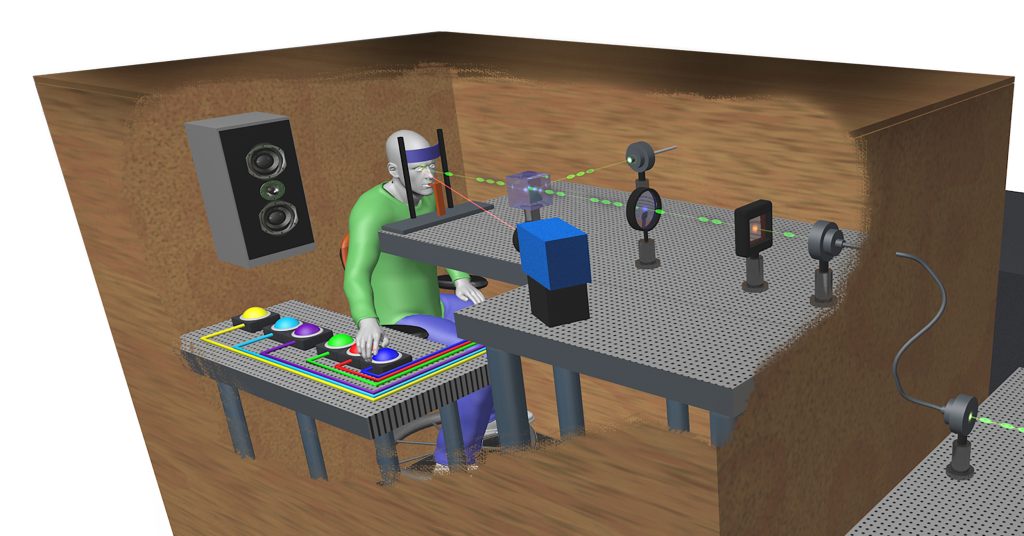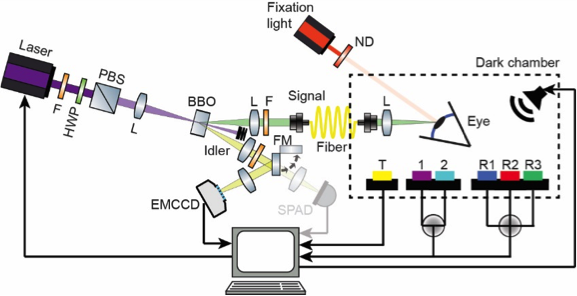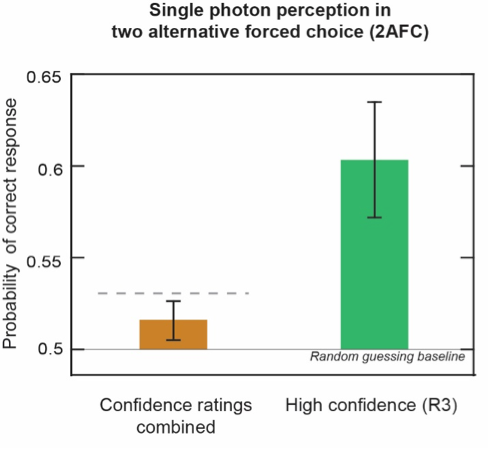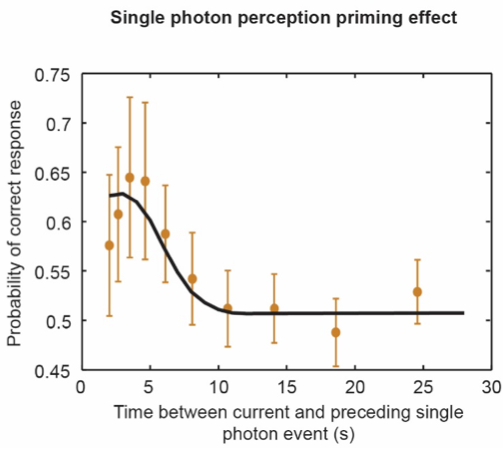Our paper entitled “Direct detection of a single photon by humans” has been published in Nature Communications.
As early as in 1940 landmark experiments by Hecht and colleagues showed that dark-adapted human subjects are capable of reporting light signals as low as a few photons (~5-7). However, as in classical light sources the distribution of the photon number follows Poissonian statistics and due to use of non-ideal psychophysical procedures, until now it remained unclear whether the visual system including the processing performed by the retina and brain is able to detect a single photon.

To answer this question, we have built a quantum light source based on the process of spontaneous parametric down-conversion (SPDC), see Fig. 1 and 2. In SPDC which is often used in quantum optics and quantum information correlated pairs of photons (called signal and idler) are produced from a higher energetic pump photon in a non-linear crystal under energy and momentum conservation. We used a customized EMCCD to detect one of them, while the other was sent towards the observer’s eye.

Such a source can be tuned to feature a small ratio of multiple-to-single photon emissions. This allowed us to create an effective single-photon light source with a sub-Poissonian photon number distribution by identifying two and multiple photon events and rejecting these through post-selection. As a result, in the trials used for analysis, subjects’ responses were due to true single photon events only.

We have performed over 30.000 trials using a rated two-alternative forced-choice (2-AFC) psychophysics procedure that improved both the sensitivity and the cross-trial reproducibility (see Fig. 3). We found that averaged across subjects and indicated confidence ratings by the subjects the probability of correct response was 0.516 ± 0.010 (p = 0.0545). As we have used a 2-AFC procedure this must be compared to the 0.5 baseline, which is the probability of random guessing. These results suggest that subjects could indeed detect a single photon with a probability above chance. In our 2-AFC we also asked the subjects to rate the confidence in all their responses. Analyzing the probability of correct response only for cases when subjects indicated a high-confidence answer yields even a higher probability of correct response and a more significant evidence for detection of single photons (0.60 ± 0.03 (p = 0.0010)). This result demonstrates that subjects can indeed detect a single photon impinging on their eye.

Further we analyzed how the probability of correct response in single-photon events depends on the time to the previously detected photon (Fig. 4). Surprisingly, we found a strong dependence on the temporal separation of the two events peaking at ~3.5 s, with a decay time on the order of seconds. We found that the probability of correctly reporting a single photon is highly enhanced by the presence of an earlier photon within ~5 s time interval. Given that this represents more than an order of magnitude of a disparity with the known integration time of the visual system suggests that a new physiological mechanism at extreme low light levels may be responsible for this phenomenon.
Finally, we developed a mathematical model based on Signal Detection Theory (SDT) that puts all our experimental observations, including the probability of single photon detection, the distribution of ratings and the above single-photon induced priming effect, within a single framework. We showed that our model can account for all our data and correctly predicted the probability of correct response at each rating.
Our results show that evolutionary pressure that have led to the optimization of a protein to the absolute physical limit could also be effectively exploited by an entire system that has co-evolved around it. In the future the use of light sources with sub-Poissonian photon number distributions might allow for a more direct access to the internal visual system’s noise and provide new avenues for probing yet undiscovered retinal pathways. Also, given the inherent quantum nature of light and the fact that single photons can be prepared in superposition states of space, time, energy and other degrees of freedom, our study opens up new, speculative possibilities to investigate to what extent such states may also bear unique physiological signatures as well as to test theoretical proposals that use human observers for experimental tests of quantum non-locality.
Relevant Publication:
Jonathan N. Tinsley, Maxim I. Molodtsov, Robert Prevedel, David Wartmann, Jofre Espigulé-Pons, Mattias Lauwers, and Alipasha Vaziri
Direct Detection of a Single Photon by Humans
Nature Communications 7, 12172 (2016).
(Download)
